DefExpo 2022 is being held in Gandhinagar, Gujarat from October 18 to 22. The aim is to showcase the might of the domestic defence industry which is now powering ‘Make in India, Make for the World’ resolve of the government.


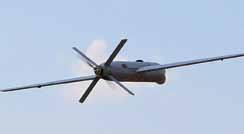
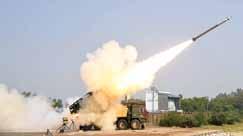
General p c. Katoch (retd)
SP’s

priorities for the newly appointed cds
The country’s arms
grown by six times since 2014, amounting to
11,607 crore during FY 2021-22
lighter, less protected vehicles in patrol and transportation roles. They are designed to counter mines and ambushes including small arms fire, IEDs, anti-tank mines and man portable RPGs
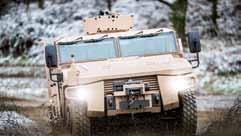
The Nation eagerly looks at General Anil Chauhan, the new CDS, for successfully taking forward the initiatives taken up by the Late General Bipin Rawat Lt GeneraL abhay KriShna (retd)

Appointment of CDS

A historic step was taken by the Government of India (GoI) on January 1, 2020 to appoint the much-awaited Chief of Defence Staff (CDS), post submission of the Shekatkar Committee Report way back in the year 2016. It was a major signal for the commencement of ensur ing complete integration of the Indian Armed Forces and providing better direction for higher defence management.
a period of intense speculation in multi domain of thoughts. Some even speculated if India really needed a CDS under the prevailing economic situation and unfolding global security scenario, where we seemed to be totally fixated with the thought of India’s compulsion with two-front warfare scenarios.
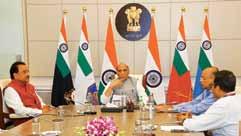
Loitering munitions have revolutionised the battlefield in recent years and more of these can be expected to fill up the airspace in future
General p.c. Katoch (retd)
The Author is a former Army Commander of the South Western, Eastern and Central Army Commands. He retired on September 30, 2019. Post retirement, he was Chief Commissioner WBRTPS Commission.
Late General Bipin Rawat, the then CDS, moved at a rapid pace to bring about the muchdesired change under the prevailing work ing environment and commence the cycle of change. However, the Nation was not destined to reap the benefits of his efforts as General Rawat unfortunately died in a tragic helicopter crash on December 8, 2021. Thereafter, commenced
However, the Government put all kinds of speculation, prevailing since nearly last ten months, to rest by appointing Lieutenant General (Lt Gen) Anil Chauhan as CDS on September 28, 2022. It was a big relief as the relevance of the Department of Military Affairs was now coming under the scanner of few think tanks. Notwith standing, this being the first instance where a retired three-star General is elevated to the sta tus of a four star General and assigned a post first among equals to all the serving Chiefs, the prevailing ethos and value system of the Armed Forces will take it as a matter of pride.

www.spslandforces.com ROUNDUP 12/2022 sp’s land forces Page 4 Unique facets of defexpo 2022
lt
Page 5 India rising up the defence exports ladder
exports have
`
and aims to reach an export target of `36,500 crore by 2025 ayushee chaudhary Page 7 protected mobility solutions Infantry Mobility Vehicles are designed to supplant
rohit Goel Page 8 Indigenous loitering munitions
lt
AN SP GUIDE P UBLICA TION The ONLY magazi N e i N a sia-Pacific D e D ica T e D TO La ND fOR ces In ThIs Issue Volume 19 No. 5October-November 2022 >> Lead Story
PhOTOGRAPh: PIB
General Anil Chauhan taking over as 2nd Chief of Defence Staff on September 30, 2022. earlier, He was the General Officer Commanding-in-Chief (GOC-in-C) of the Eastern Command and served in the role until his retirement in May 2021
MEET US AT HAll-8, STAll: 8 `100.00 (India-Based Buyer Only) DEfExpo 2022 special
Pinaka Missile
Sherpa Light
SkyStriker
The most significant devel opment amongst the military circles, in the recent past, was the appointment of General Anil Chauhan as the second Chief of Defence Staff. He took over on September 30, 2022. We, at SP Guide Publications, congratulate General Chauhan on his appointment as the CDS and wish him all the success in his new role.
General Anil Chauhan, the current CDS, has had an outstanding career with immense experience in multi domain and theatres. From Jammu and Kashmir (J&K) to the North East (NE) and Army HQ, he has held several crucial appointments. During the last one year, he also had the opportunity to acquire the critical insight into National Security matters working as Military Advisor with National Security Council Secretariat (NSCS). He is a very well-read officer who is blessed with aca
Following the untimely de mise of the first CDS, the Late General Bipin Rawat in a tragic helicopter crash on December 8, 2021, the position of CDS re mained vacant while subjected to anticipation and speculation.
Appointment of the first CDS was a historic moment for the In dian Armed Forces. Then CDS, General Rawat had moved at a rapid pace to bring about the de sired change under the prevailing working environment. The ap pointment of the new CDS came as a big relief. The Nation’s eyes are eagerly looking at General Anil Chauhan, the new CDS, for successfully taking forward the initiatives taken up by General Rawat. General Chauhan is known as a no-nonsense person who loves to take bold decisions.

Looking at the vast experience

and the visionary bent of person ality of the new CDS, he must be envisaging to give impetus to increase logistic integration and communication compatibility with a view to not only amalgamate or augment the resources but also to provide great relief to the defence exchequer. More about General Chauhan, the defence situation in the country and the tasks and challenges ahead of him is high lighted in an article penned down by Lt General Abhay Krishna (Retd), former Army Commander of the South Western, Eastern and Central Army Commands.
Further outlining the defence scenario in the country and to showcase the uprising defence industry of India, the country’s biennial show returns this month in Gandhinagar after being post poned from March. A report by
It is now an accepted fact that all major powers have an ambient Naval presence from the Strait of Hormuz to the Strait of Malacca to protect their major trade route. Thus, India needs to grow out of continen talist mindset and expand its reach not only in the Indian Ocean Region, but also close to China’s East Coast to be a meaningful coun ter threat. India, thus, needs to grow beyond the fixation of Western and Northern Land borders threat perception syndrome and instead look to reorganise herself into a
New War Doctrine
Lt General P.C. Katoch (Retd), covering the unique facets of DefExpo 2022 is a part of this issue. The aim of the Expo is to display the might of the domestic defence industry which is now powering the ‘Make in India, Make for the World’ resolve of the Government.
As a boost to Atmanirbharta, defence exports are also under focus as the Government targets `36,500 crore by 2025 for arms exports. The country’s arms ex ports have already shown a sig nificant increase since 2014. A report by Ayushee Chaudhary on government initiatives to en hance exports and a few sig nificant deals has been included. Additionally, the issue contains a report on Protected Infantry Mobility Solutions by Rohit Goel, highlighting the key role played
by them in providing protected mobility to the Infantry, their key design elements and major global developments. A detailed report by Lt General P.C. Katoch (Retd) on Indigenous Loitering Munitions is added underlining how these have revolutionised the battlefield in recent years.
All this and with a lot more. Do visit us at Hall 8, Stall No. 8S.3 at the DefExpo 2022. Happy Reading!
Jayant Baranwal Publisher & Editor-in-Chief
demic scholar abilities. He is also known as a no-nonsense person who loves to take bold decisions. The Nation therefore, eagerly looks at him for successfully taking forward the initiatives taken up by the Late General Bipin Rawat.

India’s Maritime Interests and Challenges
Notwithstanding the above, with the NSA’s address on June 30, 2022 at Multi-agency Maritime Security Group meeting, calling for ‘seamless coordination among various agencies involved in protecting India’s mar itime interests in the face of emerging secu rity challenges and increasing rivalries and competitions in the Indian Ocean’, it has become evidently clear that India’s focus is much larger than two-front war fixations. The newly appointed CDS, therefore, has a vast charter to handle. He needs to focus on protecting the nation’s economic and secu rity interests in the Indian Ocean domain by developing maritime domination as a prior ity mission.
Maritime Expeditionary Force as also create few Military bases both in the Indian Ocean Region and the Indo-Pacific Region in col laboration with friendly countries.

To begin with, keeping in mind the Nation’s Strategic goal of becoming a Regional Power, a new War Doctrine needs to be prepared to tackle the emerging threat scenario. The larger roadmap pertaining to unfolding global security challenges, emerging threat scenarios and increas ing military footprints in both the Indian Ocean Region and the Indo-Pacific Region should be clearly spelt out in the said doc trine besides the measures required to
Keeping in view our projected involve ment in the Indian Ocean Region and the Indo-Pacific Region, building Carrier Battle Groups, acquisition of Maritime Strike Aircraft and raising of Amphibi ous Divisions must be accorded priority over straight away beginning to create Western Theatre, Northern Theatre, Joint Air Defence, Peninsular and Logistics Commands. Once these tri-service forces become stable and operational, then the process of creating Theatre Commands
tackle the threats on both the Western and Northern Borders.
Crucial Areas of National Focus
The nation needs to give a much-awaited impetus to the Strategic Forces, Space and Cyber capability, Command and Control capability, shifting focus from manpower heavy Army to high-tech, modular, respon sive ground forces capable of three-dimen sional manoeuvre, long-range weapons with precision strike capability duly sup ported by special operations forces under the command of a combined military leadership ensuring jointness in planning and execution. Integrating the existing TriService Communication system to include Cyber, Space and Electronic Warfare (EW) so as to not only get and share real time intelligence at all levels, but also help coor dinate a timely and accurate response. In accordance with their interoperability, the maintenance wherewithal including spares, infrastructure and other connected assets must also be integrated.
could commence. This may take almost a decade to achieve.
Growth of the Indian Armed Forces over decades, confined into individual service verticals, has led to a major defi ciency in the planning process, duplica tion of effort and sub-optimal utilisa tion of resources. Duplication of assets in infrastructure and human resources whether in training or in operational commands, is a huge burden on the defence budget leaving very little for capital acquisition. Immediate priority should be accorded to Tri-Service Inte gration of existing resources to opti mise and reduce wasteful expenditure. This will ensure the commencement of a seamless integration of the three ser vices at various functional levels with out destabilising the complete structure. Thereafter, integrate their maintenance wherewithal on a common platform con sidering the factor of interoperability and ensure that provisioning is done under one budget head.
>> www.spslandforces.com 2 sp’s land forces 5 /2022
EDITORIAL
Understanding the enormous responsibilities that has been entrusted on the shoulders of our cds , his focus now is going to be promoting jointness in defence procurement, training and staffing for the services
Lead Story
(Left) General Anil Chauhan inspecting the Tri-Service Guard of Honour before taking over as 2nd Chief of Defence Staff; (Right) General Anil Chauhan with CAS Air Chief Marshal V.R. Chaudhari, COAS General Manoj Pande, VCNS Vice Admiral S.N. Ghormade & CISC Air Marshal B.R. Krishna.
PhOTOGRAPhS: PIB
Challenges and Tasks Before the New CDS
Rising above turf battles and Service-spe cific trivial considerations, all three Service Chiefs must assist each other and the CDS in streamlining the procurement prioritisa tion, refining the archaic procurement pro cess leading to over stocking, working out realistic stocking norms graduating from ‘Just in Case’ to ‘Just in Time’ and rework ing out the current skewed fuel efficiency norms leading to surpluses and misuse.
It is also recommended that before embarking on the creation of Western, Northern Theatre, Air Defence, Peninsular and Logistics Commands as was announced post appointment of previous CDS, a study may be carried out to look into the CDS models already being followed by the P5 countries. The US took a decade and Russia took seven years to achieve theaterisation. Before we proceed, we may consider con stituting a team to study the existing vary ing models of countries like the US, Russia, China etc and their functionality. There after, look at what suits India the best. It is always better to learn from first-hand expe rience of others. The study of the existing five models in the world will help us to iden tify a structure truly applicable and relevant to us in the backdrop of leveraging India’s geographical location advantage vis-a-vis available resources as well as economic and security interests that need to be protected. It will also help in working out a practical timeline keeping the budgetary constraints and other connected limitations in view.







India’s economy currently pitched at $3.3 trillion is still to traverse a long distance to get close to $17.7 trillion economy of the nation’s main adversary China and $19.48 trillion economy of the United States (US). In view of the committed liabilities from the previous years, the current allocation, therefore, will always fall short to meet the requirements of the Indian Armed Forces. We, therefore, have to set targets to be achieved while harmonising the available resources with realistic timelines.

Hopes and Aspirations of the Nation
Lastly, we must not forget that when the first CDS was appointed, Prime Minister Naren dra Modi had said that the post reflected the hopes and aspirations of 130 crore Indians. He further added that the CDS carried the responsibility of modernising the Indian military and newly-created Department of Military Affairs would help the Indian Armed Forces face the ever-changing chal lenges of modern warfare.

Thus, to unfold the vision of the Indian Prime Minister into a reality on ground, we need to carefully take well planned firm steps forward and make the Nation see what our Prime Minister had envisioned after the creation of the post of CDS.
To begin with, therefore, looking at the vast experience and the visionary bent of personality of the new CDS, he must be envisaging to give impetus to increase logistic integration and communication compatibility with a view to not only amal gamate or augment the resources but also to provide great relief to the defence exche quer. With acclaimed foresight of the CDS, intensified maritime domination and devel
with acclaimed foresight of the cds, intensified advancement in the domain of space and cyber capabilities is what is likely to be addressed on priority

opment along with the advancement in the domain of space and cyber capabilities is what is likely to be addressed on priority.
Theatrerisation, thereafter, will ensue as a natural resultant and need not to be pushed for as of now.

Understanding the enormous responsi bilities that has been entrusted on the shoul ders of our CDS, his focus now is going to be - promoting jointness in defence procure ment, training and staffing for the services through joint planning and integration of their requirements; facilitate restructuring of military commands for optimal utilisa tion of resources by bringing about synergy in operations; promote use of indigenous equipment by the services to set and achieve our goal to emerge as a regional power; and expand the footprint of our Armed Forces not only in the confines of the Indian Ocean Region but also close to East and South China Sea.
Lastly, for optimum utilisation of the precious time on hands, the CDS may con sider while working towards achieving our final goal of theaterisation, that other sec ondary ranked administrative issues like promotions, postings, redressal of griev ances, foreign assignments etc as also other service-related additional subordinate administrative objectives and finance mat ters are left to the respective Service Chiefs and the MoD to handle. SP
>> 35/2022 sp’s land forces
Lead Story
2022
The Nation looks at General Anil Chauhan for successfully taking forward the initiatives taken up by the Late General Bipin Rawat
TIVRA (UZI PRO) Sub-Machine Gun 9x19mm
Sub-Machine Gun/Carbine 9x19mm, 5.56x45mm
ABHAY (TAVOR X95)
Sniper Rifle
.338
BOLT ACTION
LAKSHYA (DAN) Light Machine Gun
5.56x45mm |
7.62x51mm
PRAHAR (NEGEV)
THE ULTIMATE WEAPONS OF 21 CENTURYST INDIA’S FIRST PRIVATE SECTOR SMALL ARMS MANUFACTURER Registered Office: Adani Corporate House, Shantigram, Near Vaishno Devi Circle, SG Highway, Khodiyar, Ahmedabad, 382 421, Gujrat, India Tel: + 91 124 2555942 E-Mail: sales@plrsystem.in Website: www.plrsystems.in, www.adanidefence.com
PLR9 (MASADA)
Striker Fired Pistol 9x19mm Assault Rifle 5.56x45mm, 7.62x51mm ARKA (TAVOR) PRECISE | LETHAL | RELIABLE Carbine/Assault Rifle 5.56x45mm, 7.62x39mm, 7.62x51mm JEET (ACE) Sniper Rifle 7.62x51mm ACHOOK (GALIL) PhOTOGRAPh: PIB
Unique facets of defexpo 2022
DefExpo 2022 is being held in Gandhinagar, Gujarat from October 18 to 22. The aim is to showcase the might of the domestic defence industry which is now powering ‘Make in India, Make for the World’ resolve of the government.
 Lt GeneraL P.C. KatoCh (retd)
Lt GeneraL P.C. KatoCh (retd)
INDIA’S DEFENCE ExHIBITION ORGAN ISATION is an autonomous organisa tion of the government established in 1981 to promote the export potential of the Indian defence industry. The agency is responsible for organising international exhibitions like the DefExpo and India’s participation at defence and security exhi bitions in foreign countries. To start with, DefExpo a flagship event of the Ministry of Defence (MoD) to showcase the land, naval, air as well as homeland security systems, was held biennially at Pragati Maidan in New Delhi. However, in recent years, Def Expo has been held around the country at different venues.
DefExpo 2020 was held in Lucknow, Uttar Pradesh, in February 5-8, 2020 to attract investments in the Uttar Pradesh Defence Corridor. The DefExpo 2022 was earlier scheduled from March 10-14, 2022 at Gandhinagar, Gujarat. However, this was postponed with the government cit ing logistical challenges being faced by the participants during that period. Thereafter, new dates for DefExpo 2022 announced on August 8 rescheduled the event from October 18 to October 22. The theme for this year’s expo is ‘Path to Pride’, which is aimed at invoking nationalistic pride and encouraging citizens to partake in nation building through establishing a capable indigenous defence industry.
In recent years, the government’s focus has been on the ‘Make in India’ initiative. The policy approach in this is to create a favourable environment for investments, develop a modern and efficient infrastruc ture and open up new sectors for foreign capital. The initiative targeted 25 economic sectors for job creation and skill enhance ment, and aimed to transform India into a global design and manufacturing export hub. It was to encourage companies, both public and private, to develop, manufac ture and assemble products made in India and incentivise dedicated investments into manufacturing.
The government had laid out three objectives for ‘Make in India’. These were: to increase the manufacturing sector’s growth rate to 12-14 per cent per annum; to create 100 million additional manufac turing jobs in the economy by 2022, and; to ensure that the manufacturing sector’s contribution to GDP is increased to 25 per cent by 2022 (later revised to 2025). How ever, statistics indicate that these objectives have not been fully achieved yet.
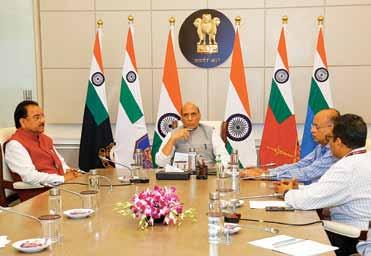
DefExpo 2022 will be held at the Heli pad Exhibition Centre (HEC), while the
defence minister rajnath singh expressed satisfaction at the preparations and encouraged the officials to make defexpo 2022 the best-ever defence exhibition
inaugural official functions and seminars are to be held at the Mahatma Mandir Convention Exhibition Centre (MMCEC).
Live demonstrations on all five days of the DefExpo are being organised at Sabarmati River Front (SRF) and ship visits for public by Indian Coast Guard (ICG) at Porbandar.
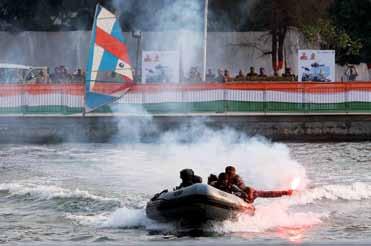
In addition, the biggest drone show by the indigenous IIT Delhi start-up Botlabs (an iDEx winner) is also being organised dur ing DefExpo 2022.
Defence Secretary Ajay Kumar reviewed preparations for the event dur ing the Apex Committee Meeting held on September 24. Chief Secretary, Govern ment of Gujarat, Pankaj Kumar and other senior officers of the state government and the Ministry of Defence attended the meeting. A statement issued after the Apex Committee Meeting read, “The 12th edi tion of DefExpo is scheduled to be held in Gandhinagar, Gujarat between October 18-22, 2022 in a first ever four-venue for mat which promises to engage the public and inspire them to join the aerospace and defence manufacturing sector for ‘Atmanirbharta’ in defence.”
The statement further said, “The aim is to showcase the might of the domestic defence industry which is now powering ‘Make in India, Make for the World’ resolve of the government and the nation at large. Over 1,000 exhibitors have registered and the numbers are anticipated to be the highest-ever recorded during the previous editions of DefExpo. Also, towards greater participation by start-ups and MSMEs, a 50 per cent discount on space charges is offered. The exhibition will also host the second edition of the India-Africa Defence Dialogue (IADD), with invites extended to 53 African countries. A separate Indian Ocean Region plus (IOR+) conclave with
participation of approximately 40 coun tries is also on the anvil.”
On September 27, Defence Minister Rajnath Singh reviewed the preparations of the forthcoming DefExpo 2022, in New Delhi. During the meeting, the Defence Minister was briefed by officials about the extensive arrangements being made by multiple stakeholders for the event. He expressed satisfaction at the preparations, while encouraging the officials to make DefExpo 2022 the best-ever defence exhi bition. Minister of State for Defence Ajay Bhatt, Defence Secretary Ajay Kumar and other senior officials of Ministry of Defence were present in the meeting.

DefExpo 2022 is unique because of the following reasons:
l It is the first-ever edition of DefExpo exclusively for ‘Indian’ companies.
l It is the largest ever DefExpo held since its inception; covering an area of 1.1 lakh square metres.
l The response from Indian companies was so huge that the closing date for reg istration had to be extended to October 5, 2022.
l It marks the celebration of one year of the formation of the seven new defence public sector undertakings (DPSUs) carved out of the erstwhile Ordnance Factory Board (OFB) and 41 Ordnance Factories (OF) under it. These seven DPSUs are also participating in DefExpo 2022 for the first time.
l Many states are participating by put ting up State Pavilions for the first time. These Pavilions would also provide the opportunity for Chief Ministers, Industries Ministers, Chief Secretar ies, among others, to solicit investment and promote their respective states thus cultivating more centres for indigenous
The exhibition will host the second edition of the India-africa defence dialogue (Iadd), with invites extended to 53 african countries and a separate Indian ocean region plus (Ior+) conclave with participation of approximately 40 countries
aerospace and defence manufacturing within the country.
l Live demonstrations at the Sabarmati River Front (SRF), ICG ship visits for public at Porbandar and the biggest drone show are being held.
l The Defence Minister’s ‘Awards for Excellence in Defence Manufacturing’ will be presented during the DefExpo for the first time.
DefExpo 2022 will certainly provide a big boost to ‘Make in India, Make for the World’ in the defence sector with more than 300 part nerships in terms of memorandums of under standing (MoUs), transfer of technology (ToT) agreements and product launches being final ised. All this will showcase the strides made by India in the defence sector and will provide an impetus to defence exports also. SP
>> www.spslandforces.com 4 sp’s land forces 5 /2022
Show Preview / d ef e x P o 2022
(Top Left-Right) The Union Minister for Defence Rajnath Singh reviewing the preparations of the forthcoming DefExpo 2022; (Above Left-Right) Glimpses from DefExpo 2020.
PhOTOGRAPhS: PIB, PRO Navy, SpokespersonMoD / Twitter
India
up the defence exports ladder
ayuShee Chaudhary
wITH A LOUD AND clear mes sage to make India a selfreliant defence nation, the Government has been push ing the “Atmanirbharta Abhiyan” extensively. From the Ministry to the DPSUs (Defence Public Sector Units), the long-established manufacturing giants to the start-ups, everyone is on board to “Make in India, Make for the world”. It has been reiterated that ‘Atmanirbharta’ does not mean isolation; it is India’s resolve to become self-dependent while fulfilling the needs of other countries. Alongside innovations, the government has also been exploring the avenues of Artificial Intelligence, Quantum communication technology, unmanned sys tems and other technical advancements for defence manufacturing & export.
According to the data released by the Ministry of Defence (MoD), with Govern ment’s increased focus on indigenisation and procurement of defence products from the domestic resources, the expenditure on defence procurement from foreign sources has reduced from 46 per cent to 36 per cent in the last four years. During this time, the Government has also accorded Acceptance of Necessity (AoN) to 162 proposals worth `2,51,130 crore approximately, under vari ous categories of Capital procurement from domestic sources. The value of defence exports during the financial year 2021-22 has been reported as `12,815 crore.
A major reform that the Ministry has undertaken is export promotion. At an event in September, the Defence Minister asserted that the Government is leaving no stone unturned to realise the dream of a ‘New India’ as titled by the Prime Minis ter, which is not dependent on any country to fulfill its needs, especially those related to security. Throwing light on the progress achieved, he underlined, “defence exports, which were once `1,900 crore, have now crossed `13,000 crore. I am confident of achieving the target of `1.75 lakh crore of defence production by 2025, which includes export of `35,000 crore.”
India witnessed a 21 per cent decline in imports during 2017-21 versus 201216 due to the growing emphasis on indig enous design and manufacturing of defence equipment. MoD also stated that the coun try’s arms exports have seen a six-times rise since 2014, amounting to `11,607 crore ($1.5 billion) during FY 2021-22 and the government is ambitious to reach an export target of `36,500 crore ($4.8 bil lion) by 2025. Defence exports of India has expanded to more than 75 countries in the world. According to Rajnath Singh, India has the potential to supply various types of



missile systems, helicopters, multi-purpose light transport aircraft, warships, artillery gun systems, patrol vessels, radars, tanks, armed vehicles, digital warfare










The Government has taken several policy initiatives in the past few years and brought in reforms to encourage indig enous design, development and manu facture of defence equipment, thereby














promoting self-reliance in defence manu facturing & technology in the country. Some of the important steps, as shared by the Ministry, include:
According priority to procurement of capital items from domestic sources under Defence Acquisition Procedure (DAP)-2020. The announcement of 18 major defence platforms for industry led design & development in March 2022.
>> 55/2022 sp’s land forces i ndu S try / e x P ort S
systems, etc, to the world.
l
The value of defence exports during the financial year 2021-22 has been reported as `12,815 crore The country’s arms exports have grown by six times since 2014, amounting to `11,607 crore during FY 2021-22 and aims to reach an export target of `36,500 crore by 2025
rising
India’s defence exports (in ` crore) 2018-19 2019-20 2020-21 2021-22 2022-23 (till June 2022) Total Export Value 10746 9116 8435 12815 1387* *provisional Continued on page 10... Trusted Partner to the Indian Armed Forces K9 VAJRA-T 155 mm/52 Cal. Tracked Self Propelled Gun For more information on our defence systems contact: Defence@Larsentoubro.com Regd. Office: Larsen & Toubro Limited, L&T House, N. M. Marg, Ballard Estate, Mumbai - 400 001, INDIA ON: L99999MH1946PLC004768 The company does not manufacture any explosives or ammunition of any kind, including cluster munitions or anti-personnel landmines or nuclear weapons and also does not customise any delivery systems for such munitions. TRAJAN® - 155 mm/52 Cal. Towed Gun System Pinaka Multi-Barrel Rocket Launch System Grad BM-21 Upgrade: Multi-barrel Rocket Launcher Upgrade 155mm/ 52 Cal. Mounted Gun System (MGS) Armoured Systems Complex (ASC), Hazira Strategic Systems Complex (SSC), Talegaon Precision Manufacturing & Systems Complex (PMSC), Coimbatore
russia’s smart weapons Team
HIGH P RECISION W EAPONS
HOLDING (HPW) was founded in 2009 as a subsidiary of the Ros tec State Corporation. According to the Government decision the Holding’s goal is “to create advanced weap ons, military and special equipment in the field of high-precision weapons based on innovation and technological modernisa tion of the existing production base”. In other words, to make the Russian weapons smarter, up-to-date and cost-efficient.
The Holding unites national leading enterprises such as Tula-based Shipunov KBP Instrument Design Bureau, Kolomna-based
KBM Machine-building Design Bureau and Kovrov-based VNII Signal Research Institute being teamed by a number of research and production facilities all over Russia, includ ing Kurgan, Saratov and Volsk. The Holding headquarters is located in Moscow.
The combination of design and produc tion facilities allow HPW to gain the leading position in the field of smart weaponry in Russia and internationally.
HPW is especially strong in the field of development and serial production of the operational-tactical missiles such as Iskan der-M and various air defence systems includ ing Pantsir-family SHORADS and Igla/Verba-
family MANPADS. The Holding is also keen in the sphere of anti-tank missile systems and assault armament complexes with the Kor net, Khrizantema, Ataka and Konkurs.
Another strong field of HPW activ ity covers a range of weaponry for the armoured vehicles to include various com bat turrets such as Bereg, Berezhok and Bakhcha, as well as active protection for the armour, namely Arena and Drozd.

HPW is also responsible for the artil lery command-reconnaissance equipment, automatic guns, and a variety of small arms, including those for special troops and law-enforcement units.
The most demanded HPW products at the international market are Kornet-E ATGM and Pantsir-S1E SHORADS so far being delivered to dozens of nations in the Middle East, Asia, Africa and Latin America.
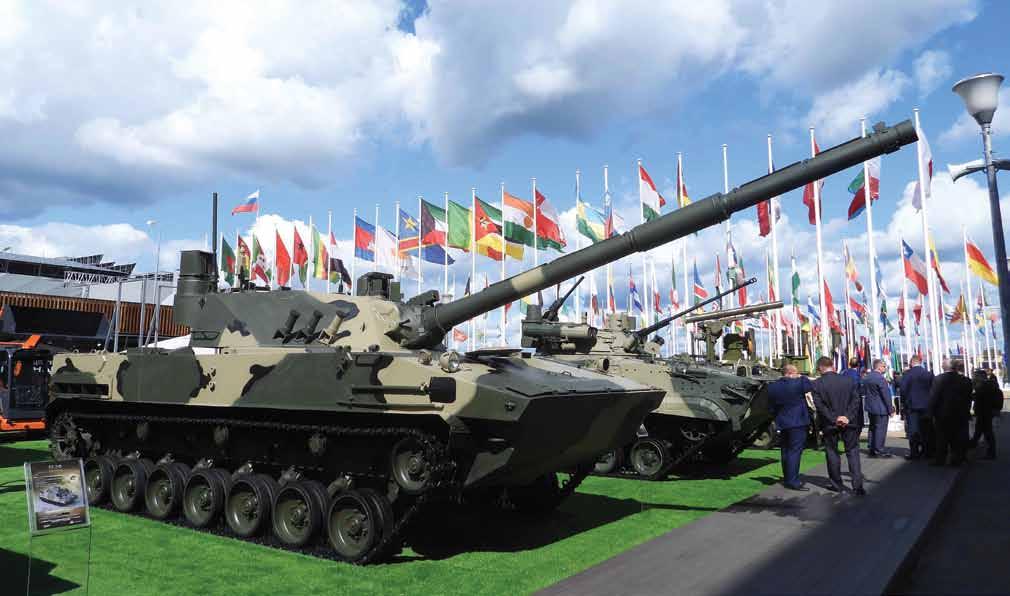
As a legal participant of the Russia’s system of the military-technical coop eration with foreign nations, the Holding has been entitled for direct operations on upgrade, maintenance, spare parts sup ply and personnel training for the mili tary equipment being already provided by the Russian State according to the export contracts. SP

>> www.spslandforces.com 6 sp’s land forces 5 /2022
2S25 125-mm self-propelled anti-tank gun posesses the fire-power of MBT
(Left) BMP-3 IFV was shown at Army-2021 Forum with Berezhok turret; (Right) Khrizantema-S self-propelled anti-tank system shown at Army-2021 Forum.
h i G h Pre C i S ion w ea P on S h o L din G / t e C hno Lo G y
protected mobility solutions
Infantry Mobility Vehicles are designed to supplant lighter, less protected vehicles in patrol and transportation roles. They are designed to counter mines and ambushes including small arms fire, IEDs, anti-tank mines and man portable RPGs
rohit GoeL
aN INFANTRY MOBILITY VEHI
CLE (IMV) was developed bear ing in mind the threats of mod ern warfare, with an emphasis on crew protection and mineresistance. IMVs are typically designed to have much greater protection than other armoured vehicles, with crews able to sur vive blasts that would be lethal in more conventional armoured personnel carriers.
Designed to Protect
IMVs are typically much heavier than unarmoured vehicles, with weight typi cally greater than six tonnes, and ranging to as much as thirty. The front and side windshields will be made of ballistic glass. They generally feature a v-hull shaped underbelly with additional crew protec tion features such as four- point seat belts and seats suspended from the roof or sides of the vehicle. IMVs are resistant to small arms and explosives but aren’t designed to defeat heavy machine gun and cannon fire, or shaped charge attack. Infantry Mobility Vehicles carry weapons typical of armoured personnel carriers. Many feature a machine gun on the roof, either on a ring mount or a remote weapon system. Being designed for patrol and transportation rather than direct combat, they are designed to have good on road mobility. They are often capable of road speeds approaching or exceeding 100 km/h, high for an armoured vehicle.
Major Global Developments
AJBAN 4X4
The AJBAN 447A Multi-Role Armoured Vehicles are designed for use in a wide range of specialist military roles. They offer high levels of survivability, mobility, and firepower. The seven-seater 447A features a highly configurable armoured cabin, designed for functions such as Tactical response, Border patrol, Reconnaissance, Counter-insurgency, Special Forces. The vehicles offer a modular design based on a conventional powertrain layout, with scalable levels of ballistic, mine blast, and IED protection.
A highly mobile 4x4 protected vehicle, the AJBAN 440A incorporates the latest technologies in ballistic and blast protection. Designed for the harshest environments, the vehicle offers exceptional off-road capabili ties, unparalleled reliability, and high perfor mance. Due to the modular nature of the vehicle, it can be configured to suit a variety of operational roles and catering for various mission systems. This allows user to have a single fleet for a multitude of requirements whilst ensuring common logistic support and thereby lower the lifecycle cost.
The AJBAN MK2 is a 4x4 ballistic and blast protected light tactical patrol vehicle for a crew of five. This multi-role capacity vehicle is constructed with a V-hull unit structure for effective mine-blast protec tion and a ballistic-protected rear cargo
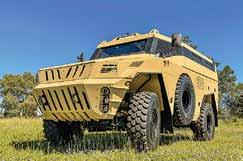
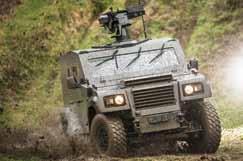

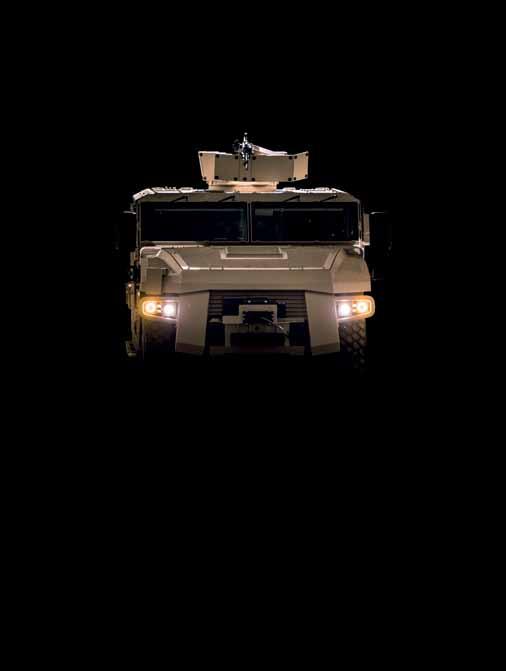
is also developing an unnamed version of dagger under its robotisation programme
compartment. Capable of accommodating a roof-mounted self-defence weapon, the vehicle also has full-time four-wheel drive powered by a diesel, water-cooled turbo charged engine. A central tyre inflation system (CTIS) allows tyres to be inflated or deflated to meet terrain conditions.
DAggEr
Designed to meet the mission requirements of armed forces worldwide, Dagger is a 4x4 light armoured vehicle currently opera tional with the French Army and other armies across Europe, Africa, and South America. It is used for troop transport, liai son, surveillance, and search-and-rescue (SAR) missions. The light-armoured unit is available in four major variants for per sonnel transport, a liaison or command, a troop carrier, and an internal security vehi cle. Arquus is also developing an unnamed version of Dagger under its robotisation programme.
Dagger light armoured vehicle is based on a reinforced tactical vehicle chassis, which integrates a 4×4 wheel drive layout with an all-wheel drive configuration. The vehicle offers superior off-road capability and angle of attack and exit. The hull is fit ted with a large windshield at the front, two doors on either side and an exit door at the rear for easy ingress and egress of troops. Its maximum passenger carrying capacity of the troop transport vehicle is six, while the internal security and liaison vehicles can accommodate up to five and four occu pants respectively. The light tactical vehicle features a roof-mounted weapon station, which can be armed with a 12.5mm or a 7.62mm machine gun. It features a single roof hatch for the gunner’s position. Other armament includes individual teargas gre nade launchers and a multi-tube teargas grenade launcher.

Dagger 4×4 vehicle offers superior pro tection to the on-board crew and soldiers, in compliance with the STANAG 4569 stan dards. It protects the occupants from bal listic threats, bullet firings, shells, splinters, anti-tank mines, and improvised explosive devices (IED). Protection levels can be fur ther improved with the installation of jam mers and nuclear, biological and chemical (NBC) protection systems. It is air transport able by C-130 or A400 military transport
aircraft and can be easily deployed to the mission locations.
EAgLE
The combat proven EAGLE Family of Vehicles is NATO interoperable and in ser vice with various armed forces. It offers a high payload and a large protected interior in addition to a flexible load space at the rear of the vehicle. Depending on the mis sion role, 4x4 or 6x6 versions are avail

able. Both versions in the family uses the same chassis and drive train components, offering unmatched payload/gross vehicle weight ratio and a flexible internal layout to support various mission roles like Com mand & Liaison, Reconnaissance, Police/ Special Forces, Patrol, Artillery Forward Observation, EOR/EOD or others to meet customer specifications. Variants include

>> 75/2022 sp’s land forces i nfantry / Mobi L ity
arquus
Continued on page 11... SHERPA LIGHT PROTECTIONCERTIFIED MOBILITY MODULARITY
DEFENSE MOBILITY SYSTEMS
ARQUUS-DEFENSE.COM
(Top Left-Right) AjBAN-447A by NIMR; Dagger by ARqUUS; Eagle by GDELS; (Above Left-Right) Mbombe from Paramount Group; Milkor 4×4 from Milkor; PATRIOT II from EXCALIBUR ARMY.
PhOTOGRAPhS:
NIMR, Arquus, GDELS, Excalibur Army, Milkor, Paramount Group
Indigenous loitering munitions
Lt GeneraL P.C. KatoCh (retd)
KAMIKAzE DRONES ARE ALSO called Suicide Drones albeit the more appropriate nomenclature is Loitering Munitions. Latter is derived from their ability to loiter around in the target area for some time and take out the targets once located. Loiter ing munitions enable much faster reaction against hidden targets that emerge momen tarily or for brief periods. This enables selec tive targeting without the need to place own high-value targets closer to the target area and exposing them to enemy’s long range weaponry. Loitering munitions can hunt for a target by a human-driven process from a control station, autonomous flight with authority to strike designated targets, or a combination of these methods. Although there are options for recovering some mod els that do not engage a target, the muni tion is generally assumed expended once launched.
Loitering Munitions
In the 1980s, a number of programmes had begun with the requirement for a low-cost air-launched system to aid in the destruc tion of enemy air defence networks. The proposed unit would combine elements of cruise missiles and UAVs. It would be launched in large numbers by heavy bomb ers, fighters, or possibly mass ground launch systems and designed to fly into hos tile airspace and loiter until it detects and homes on to a radar and destroys it.
The above allowed the attacking force to place relatively cheap munitions in place over suspected surface-to-air missile (SAM) sites, and to attack promptly the moment the SAM battery is visible. This integrated the use of a drone as a baiting decoy with the attack role into one small and relatively cheap platform in comparison to the alter native wild weasel jet fighter. So, loitering munitions were first deployed in the role of Suppression of Enemy Air Defence (SEAD) in the 1990s.
Loitering munitions differ from cruise missiles in that they are designed to loiter for a relatively long time around the tar get area, and from unarmed combat aerial vehicles (UCAVs), in that, loitering muni tions are intended to be expended in an attack and has a built-in warhead. There fore, loitering munitions fall between cruise missiles and UCAVs and are also cheaper and cost effective. Further development of loitering munitions commencing early 2000s increased their strike range and loi ter time. But in addition to longer range and longer loiter time, miniature versions were developed to support tactical roles; very short range battlefield systems that could fit into the backpack of frontline soldiers.
Developments in India
Earlier this year, three different types of indigenously designed and developed loiter ing munitions by Economic Explosives Ltd in partnership with the Bengaluru-based start-up zMotion Autonomous Systems
Pvt Ltd were successfully tested in Ladakh from March 21 to 23, 2022 in high alti tude. The tests were conducted at altitudes of over 15,000 feet and all the three loiter ing munitions achieved their endurance targets after taking off from high altitude areas. The three loitering munitions (two fixed wing variants and one hexacopter) are expected to be at least 40 per cent cheaper than imports from Israel and Poland.
The above trials were facilitated by the Army Design Bureau (ADB) to rate the performance and safety standards of these systems. These man portable munitions can take off with a 4 kg warhead, flying for an hour and homing at ground-based tar gets with precision. Such munitions, much cheaper to produce than armed drones, can cause disproportionate damage to conven tional targets like ground-based bunkers, command centres, artillery and armoured formations.
Concurrently, there were news reports that the Indian Army has procured 100 x WARMATE Micro Loitering Munitions from Poland for the Army’s Special Forces. With
a range of 30 km, altitude 300 metres and 5.7 kg payload (high explosive and thermo baric), these can be effectively used against enemy forces and lightly armoured vehicles. Another news report of June 27, 2022, indi cated that Poland’s WB Group has completed delivery of around 120 WARMATE 3.0 fixedwing loitering munitions to the Indian Army. The report stated that these are to equip artil lery units to engage permanent and dynamic targets in plains, deserts, semi-desert, moun tainous terrain and high-altitude areas. The media report further said that the procure ment of ten sets comprises ten launchers, 30 forward observation stations and 120 loiter ing munitions, all covered under a five-year comprehensive maintenance contract.

Now there is more good news about indigenous loitering munitions, in that, a team of young engineers of TATA Advanced Systems Limited (TASL) has developed indigenous loitering munitions – the ALS 50. The ALS 50 successfully demonstrated its strike capability during tests conducted at Pokhran firing ranges on September 22, 2022. According to sources, the ALS 50 accurately hit the ground target with an explosive warhead during trials. This indig enous loitering munitions is capable of operating in all types of operational areas including from difficult terrain and highaltitude areas.
The ALS 50 is an autonomous system designed for Vertical Take Off and Landing (VTOL). The VTOL capability gives the sys tem the ability to operate in areas where limited space is available, like narrow val leys, fortified mountain positions, small jun gle clearings and the decks of warships. The ALS 50, which can take off like a quadcop ter, transitions into fixed wing mode during flight for long distance travel; also demon strated its ability to operate from high alti tude areas during tests in Ladakh earlier this year. The autonomous targeting system enables accurate identification and homing on to a pre-determined target. The system can also be scaled up to increase range and payload capability, as per requirements of the Armed Forces. Future development can also include integration of Artificial Intelli gence (AI) and swarming capabilities.
Loitering munitions have revolutionised the battlefield in recent years including in the ongoing conflict in Ukraine. More and more of these can be expected to fill up the airspace in future. The Indian Armed Forces have been looking to induct a range of loi tering munitions; relatively low cost ‘suicide drones’ that can be used to accurately take down high value targets like command cen tres, missile launchers and enemy armour. Looking back one can say that had India opened the defence sector to the private industry in early 2000s, we would have possibly been at par with China in unarmed aerial vehicles (UAVs) and loitering muni tions by now.
According to news reports of September 27, 2022, the Army will soon induct loiter ing munitions amid the continuing face-off with China in Eastern Ladakh. The report says that delivery of precision strike kami kaze drones is set to begin under an emer gency procurement contract inked with an Israeli-Indian joint venture in 2021. Media has quoted an unnamed defence official who said, “The Army is also in the pro cess of procuring indigenously developed advanced loitering weapon systems with enhances strike capabilities. There has been an enthusiastic response from Indian com panies in manufacturing such systems.”

The above developments in loitering munitions are indeed encouraging and the ALS 50 is reportedly is to be inducted into the Armed Forces in the near future. At the same time, the requirement of various types of loitering munitions in the Armed Forces is large considering that these would also be used in swarms in future conflicts.
The requirement, therefore, is of mass pro duction and minimal red tape for faster induction. SP
>> www.spslandforces.com 8 sp’s land forces 5 /2022 Ma K e in india / P re C i S ion Munition S
Loitering munitions have revolutionised the battlefield in recent years and more of these can be expected to fill up the airspace in future
PhOTOGRAPhS: ZMotion, Elbit Systems
(Top) Trinetra - Electric Loitering Ammunition System from ZMotion; (Above) Tactical ‘SkyStriker’ Loitering Munitions from Bengaluru-based Alpha Design
The Indian a rmed forces have been looking to induct a range of loitering munitions, relatively low cost ‘suicide drones’ that can be used to accurately take down high value targets
The requirement of various types of loitering munitions in the armed forces is large considering that these would also be used in swarms in future conflicts
pantsir-s1m short-range air defence missile and Gun system


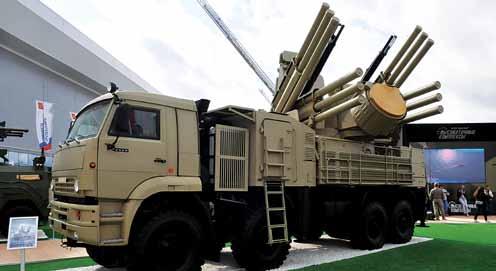
THE PANTSIR-S1 AIR DEFENCE missile and gun system is shortrange, last stand protection against high-precision weapons, like the cruise missile raids, and manned aircraft with onboard weapons. The PantsirS1 ADMGS successfully copes with this task due to missile and gun armament with solid engagement area of 20 rm in range and 15 km altitude, radar-optical target detection and weapon guidance systems. The weapon systems carry considerable ammunition load of 12 surface-to-air missiles and 1400 pieces of 30 mm gun rounds. And all this is installed on a single truck chassis with capacity of around 20 tons. the weapon system allows engagement of targets on the move, providing air defence of both station ary objects, as well as mobile units.
What has changed since the creation of the weapon system at the turn of the 21st century? Primarily, the air threats have changed considerably, an extensive experi ence of the weapon system combat employ ment has been gained, the trends of further evolution of the air attack assets have been determined, the real danger posed by the mini-drones, which currently perform not only reconnaissance, but also assault mis sions, has been realised.
It appears, the disputes on whether the MLRS projectiles are the targets for AD sys tems have wrapped up. Obviously, they are, both from the point of view of the weapon system self-defence, as well as for protection of the defended object.
Besides, how do the short-range weapon system primary targets, i.e. cruise missiles, evolve? The production of subsonic cruise missiles is being curtailed. The cruise mis siles of the nearest future are hypersonic. Undoubtedly, such situation accelerates the development and manufacture of these mis siles, especially due to termination of interme diate-range and shorter-range missiles treaty
Upon analysis of the above aspects, the KBP Design bureau has made a decision to create a new generation Pantsir-S1M shortrange air defence missile and gun system. The implemented engineering solutions meet all the current and future requirements imposed on countering modern air threats and outperform the existing counterparts. Compared to the serially produced PantsirS1 system, the new Pantsir-S1M employs high-velocity SAM with the engagement range of up to 30 km and altitude of up to 18 km, with curtain-type kinetic action warhead thrusting a cloud of high-density fragments in front of the target following the uplink command. This provides effec tive engagement of a target due to kinetic
hypersonic velocity imparted to the SAM after lift-off; low deceleration at the trajec tory and added velocity of oncoming target; alignment of target and penetrators cover age area at ultra-high striking velocities.
The improvements implemented in the new Pantsir-S1M weapon system do not involve introduction of the new SAM type only. In order to enhance the efficiency of “standard” SAM employment the control system has also been upgraded with the number of targets kept on fine tracking in radar mode increased up to four.
The combat vehicle of the new Pan tsir-S1M system comprises the following recently-designed sub-systems:
l The search radar with two phased antenna arrays (PAAs), two transceiving systems, 2D electronic scanning in eleva tion and azimuth, providing the following:
– the opportunity to detect ballistic tar gets, particularly, due to the employ ment of the sector-search mode
– increase of the detection range up to 80 km and increase of the number of detected targets up to 40 pcs
– increased reliability due to redun dancy of the basic components of the PAA with the transceivers
l The multifunctional tracking radar (TTR) with the increased surface of the PAA and increased power of the trans mitter providing:
– increase of the detection and acquisi tion range of a target with RCS=1 m2 by 1.5 times
– increase of the transceiver band by 2 times
– decrease of the target tracking errors
– simultaneous fine tracking of 4 targets l The optronic system (OES) provides auto matic and semi-automatic determination
(Left and Right)
The modular concept of Pantsir enables mounting also on tracked chassis and in stationary version

of the missile and target coordinates in the optical band, surveillance of the airspace and target search by the operator, measur ing the range to the target. The OES com prises thermal imaging and TV channels, laser rangefinder, TV auto-tracker and optronic sensor for localising the SAM. Thus, the OES provides operation under the condition of reduced transparency of the atmosphere. The system performance range surpasses the range of the meteo rological visibility by 5 – 10 times, which enables target detection and determina tion of target front and side projections coordinates with the specified accuracy.
l The central computer with increased performance and extended memory capacity, high-level language program ming allows data recoding. l The workstations with console comput ers instead of displays with enhanced ergonomics and functional capabilities of the mapping computer and imagery data recorder.
The integrated multimode and mul tispectral radar-optical guidance system operating in dm-, mm- and IR-wavebands provides for high immunity of the PantsirS1M system to jamming and, thus, for sharp rise of combat performance.
The mobile version of the Pantsir-S1M system comprises of combat vehicle (up to 6 CVs in a battery) with two types of surfaceto-air missiles, 30-mm rounds, transport ing-loading vehicle (one vehicle per 2 CVs), maintenance assets and training aids.
The modular concept of the PantsirS1M system design enables its mounting on wheeled and tracked chassis, as well as employ ment as a stationary version. The modular configuration concept enables to employ the system for protection of oil rigs, vital admin
istrative, military-tactical and other pin-point objects, as well as to install it on railway plat forms. This results in low-cost integration of the weapon system into an existing system of maintenance, training and logistics being in service with a particular customer. The said concept also enables system customisation for the specific geographical conditions of system application by a customer.
The modern air defence missile and gun system application environment strictly requires complete integration of the system data acquisition assets into the unified air defence system of a customer. The said neces sity is stipulated by the following factors: l availability of integrated targets surveil lance data on all levels and all compo nents of the unified air defense system l complicated topographical conditions require flexible target distribution not only between the CVs in a battery but also within the unified air defence system l steady increase of the number of HPWs and UAVs among employed air threats stipulates for peculiarities of anti-air craft systems application involving the capability to operate a CV without radar emission while gathering all required information from neighboring CVs and external search radars.
Availability of an inherent mapping com puter employing digital area maps in the sys tem allows for effective automatic mission planning taking into account the specific geotopographical conditions of a customer.
The Pantsir-S1M new generation weapon system is highly efficient in repulsion of con temporary and advanced HPW raids, which makes it the major component of a SHORAD system and an unrivaled solution for forming an indispensable and sufficient AD system under actual economic conditions. SP
>> 95/2022 sp’s land forces K b P / t e C hno L o G y
(Left) Pantsir-S1; (Right) Pantsir-S1M was unveiled at Army-2021
l Notification of three ‘Positive Indigeni sation Lists’ of total 310 items of Ser vices and two ‘Positive Indigenisation Lists’ of total 2,958 items of DPSUs for which there would be an embargo on the import beyond the timelines indi cated against them.
l Simplification of Industrial licensing process with longer validity period.
l Liberalisation of Foreign Direct Invest ment (FDI) policy allowing 74 per cent FDI under automatic route.
l Simplification of Make Procedure, launch of iDEx scheme involving start ups & micro, small and medium enter prises (MSMEs). Under the iDEx (Inno vations of Defence Excellence) route, as of August 2022, 136 start-ups had been engaged and 102 contracts had been signed for prototype development. The Government also approved a central sector scheme for iDEx with budgetary support of `498.78 crore for the five years from 2021-22 to 2025-26.
l Implementation of Public Procurement (Preference to Make in India) Order 2017.
l Launch of an Indigenisation portal namely SRIJAN to facilitate indigeni sation by Indian Industry including MSMEs. As of August 2022, more than 21,000 defence items, which were ear lier imported, have been displayed on the portal. 388 private vendors have expressed interest in indigenising more than 4,700 items and so far 410 items have been indigenised.
l Reforms in Offset policy with thrust on attracting investment and transfer of Technology for Defence manufacturing by assigning higher multipliers.
l Establishment of two Defence Industrial Corridors, one each in Uttar Pradesh and Tamil Nadu.
l Opening up of Defence Research & Development (R&D) for industry, start ups and academia with 25 per cent of defence R&D budget.
l Progressive increase in allocation of Defence budget of Military modernisa tion for procurement from domestic sources, etc.
The Minister called upon the Indian defence industry to identify and manufac ture state-of-the-art cost-effective products/ technologies to realise the vision of a ‘New India’ that not only caters to its own needs, but also fulfills international requirements.
“The constantly-evolving global scenario has led to an increase in demand for military equipment across the world, with countries focussing on bolstering their security sys tems. I urge the industry to take advantage of this current golden period of the Indian defence sector and enhance participation through increased investment in the two defence corridors.”
Defence Minister underlined that the government has played the role of an incu bator, catalyst, consumer and facilitator in the case of private industry. Several steps have been taken by the Ministry under the Government’s ‘Make in India’ and ‘Selfreliant India’ initiatives to change the old traditions, and create a manufacturing cli
Brahmos

mate, in which the public and private sec tors could participate. “The magnitude of all these efforts is beginning to come before us. Today we are not only producing to meet our own defence needs, but also fulfilling the defence needs of many other countries under ‘Make for the World’. It is a matter of great happiness that defence exports have increased manifold from what we used to have. We used to be counted as one of the biggest arms importers in the world until now. But today we are one of the top 25 arms exporting countries of the world.”
As of August 1, 2022, the defence exports in the country stood at `1,381 crore in FY 2022-23. The country is tar geting to export military hardware worth `35,000 crore ($5 billion) in the next five years, and seems to be going strong towards that goal since multiple deals have been signed in the recent past and many more seem to be on the way as the govern ment continues to press on “Make in India, Make for World”.
“The Indian Defence sector, the second largest armed force, is at the cusp of revolu tion. Defence exports grew by 334 per cent in the last five years; India is now exporting to over 75 countries due to collaborative efforts,” PIB had shared towards the end of September.
In the fiscal year 2021–2022, India’s exports of defence and technology products reached a record high of `12,815 crore, up 54.1 per cent over the previous year. It is pertinent to note that exports increased by approximately eight times in the fiscal year 2022 compared to the last financial year. According to the Department of Defence Production, some of the major export des tinations for defence products have been Italy, Maldives, Sri Lanka, Russia, France, Nepal, Mauritius, Israel, Egypt, UAE, Bhu tan, Ethiopia, Saudi Arabia, Philippines, Poland, Spain and Chile etc. The major defence items being exported are Personal Protective items, Offshore Patrol Vessels, ALH Helicopter, SU Avionics, Bharati Radio,
Coastal Surveillance Systems, Kavach MoD II Launcher and FCS, Spares for Radar, Electronic System and Light Engineering Mechanical Parts etc.
Some of the major deals have been listed below:
l BrahMos Aerospace Private Limited (BAPL) signed a contract with the Department of National Defence of the Republic of Philippines on January 28, 2022 for supply of Shore Based AntiShip Missile System to Philippines. The BAPL is a joint venture company of the Defence Research and Development Organisation (DRDO). The contract is an important step forward for Gov ernment of India’s policy of promot ing responsible defence exports. The crucial export deal is estimated worth $375 million (`2,770 crore). This deal is likely to open doors to India’s defence exports to various Asian countries such as Indonesia and Vietnam. India is also in talks with some Middle Eastern coun tries such as the UAE and Saudi Arabia for exporting the Brahmos missile and Akash air defence missiles.

l Towards the end of September, in another significant move towards uplift ing India’s defence export, an export order for missiles, rockets, and ammuni tion to Armenia was signed. The value of the contracts is estimated to be worth over `2,000 crore. Additionally, a num ber of contracts for the supply of arms and ammunition to Armenia were also done through the government-to-gov ernment route.
l In August, India and Argentina also agreed to enhance cooperation in the Defence sector. India’s External Affairs Ministry acknowledged Argentine inter est in the Made in India TEJAS fighter air crafts for Argentine Air Force likely to be a deal in the future, alongside exchange of visits between Armed Forces, defence trainings and collaboration for joint pro duction of defence related equipment.
l Bharat Dynamics Limited (BDL) shared that Tanzanian delegation’s visit along with their Defence Minister will give a fillip to realisation of various export orders for the company. BDL is offer ing Anti-Tank Guided Missiles, Surface to Air Missiles, Underwater weapons, Counter Measure Dispensing System, Drone delivered bombs and Drone deliv ered missiles for export to Tanzania and other friendly foreign nations.
l Earlier this year in January, Hindustan Aeronautics Limited (HAL) had revealed that it had signed a contract with the Government of Mauritius (GoM) for export of one Advanced Light Helicopter (ALH)-MkIII for Mauritius Police Force. Mauritius already operates an ALH and Dornier Do-228 aircraft built by HAL. The emphasised focus on self-reliance is not only likely to strengthen India’s defence position in the current highly volatile geopo litical scenarios but also enhance its strate gic independence as well as boost the econ omy and global relations. The defence sector promises to play a vital role in making India a $5 trillion economy with defence exports making a significant contribution.
>> www.spslandforces.com 10 sp’s land forces 5 /2022 i ndu S try / e x P ort S
SP India rising up the defence... Continued from page 5
aerospace has signed a contract with the republic of philippines in January 2022 for supply of shore Based anti-ship missile system
argentine interest in the made in India TeJas fighter aircrafts for argentine air force likely to be a deal in the future
major Defence exports: (Top) BrahMos Supersonic Cruise Missile; (Above) Enhanced PINAKA
PhOTOGRAPhS: PIB
an easy to operate, on-board vehicle diag nostics system. The EAGLE survivability standards provide proven mine, Improvised Explosive Device (IED) and ballistic protec tion that was previously achieved only in vehicles twice its weight. The vehicle allows for a flexible internal layout to accommo date a large number of staff or mission sys tems and material.
The modular, upgradeable and exchange able protection concept is adaptable to vari ous threats, with validated ballistic, antimine, Improvised Explosive Devices (IED) and Rocket Propelled Grenades (RPG) protec tion. Unique De-Dion suspension with large axle articulation and high wheel travel; Roll stabilizer system allows axle twisting and restricts body rolling; High power-to-weight ratio; High torque CUMMINS diesel engine, with Allison automatic transmission; Safe on-road handling with exceptional perfor mance; Proven in all climate zones.
MBoMBE 4
Drawing on the exceptional heritage of the Mbombe 8x8, now in production following its launch in 2016, and the Mbombe 6x6, which has entered service, the Mbombe 4x4 completes the highly advanced Mbo mbe family of combat vehicles. Displaying a striking new design, packed with the lat est technologies and capabilities required
7
tion. The monocoque hull structure of the vehicle offers a high degree of stability, flex ibility, and strength required during key missions. It also enhances the reliability and operational efficiency of the vehicle. The maximum speed attained by the vehicle is 110 km/h, while the maximum range is 1,000 km. Its large monobloc windshield enhances the situational awareness of the crew. The vehicle features a single hydraulic ramp at the rear, enabling the entry and exit of troops and crew.
Milkor 4×4 APC is manned by a crew of two including a driver and a chief com mander. The spacious cabin offers seating to accommodate eight infantry personnel. Its modular layout enables conversion of the base vehicle to multiple mission con figurations such as command, ambulance and police. The vehicle is fitted with a roofmounted remote-controlled weapon station armed with a 12.7mm machine gun. The weapon station can also be mounted with an automatic grenade launcher. The Milkor 4×4 APC also features smoke grenade launchers, and several weapon mounts that can be armed with artillery systems. It offers Level B7 ballistic and mine protection to the on-board crew and infantry troops. It pro tects the occupants against ballistic threats, small arms, shell splinters, fragmentation warheads, and mine explosives.
of the vehicle, provide high firing power and increase the defence capacities of the crew.

ShErPA LighT
The Sherpa Light family of 4x4 tactical and light armoured vehicles from are designed to provide light forces (infantry, paratroop ers, marines, internal security, etc) with the best mobility/payload compromise of its category. Sherpa Light is a complete fam ily of tactical vehicles sharing the same 4x4 chassis made specifically for military needs and offering high performance in terms of mobility, protection and payload. The Sherpa is suited for tactical missions such as scouting, patrol, convoy escort and command and liaison. It is able to transport up to four or five soldiers or a total payload of up to 4 tonnes. In addition to its out standing on and off-road performances, the Sherpa Light is fully air transportable (A400M/C-130), multirole and ready for being up-armoured (ballistic and mine kits). The Sherpa Light has already been adopted by NATO, France and other countries, is already deployed in all theatres of opera tions and in all configurations, and has been combat-proven on several occasions. More than 1,200 Sherpa Light vehicles have already been ordered and delivered, a major milestone that recognizes the Sherpa Light’s design quality, versatility and durability.
Indian Programme
In April this year, the Tata Advanced Sys tems Limited (TASL) handed over the first of such Infantry Protected Mobility Vehicles (IPMVs) to the then Chief of Army Staff, General M.M. Naravane. These combat vehicles, named Infantry Protected Mobil ity Vehicles (IPMVs), have been tried and tested in the mountainous terrain of the Ladakh region and have been inducted to boost the capabilities of the troops deployed there. These IPMV include TASL’s in-house designed and developed remote-controlled weapon station with thermal sights and external add-on armour protection pan els developed by the Defence Metallurgical Research Laboratory of the DRDO. TASL is now the first private sector company in the country to produce such wheeled armoured personnel carriers and has developed the IPMV in collaboration with DRDO.
for the modern battlefield and ever-evolving threats, the Mbombe 4 offers outstanding levels of protection, mobility and flexibility.
The Mbombe 4 shares a ‘conventional’ or ‘in-line’ automotive driveline configura tion, positioning the powerpack at the front of the vehicle and along its centre line. This configuration results in far greater effi ciency in terms of the transfer of power from the powerpack to the wheels, as the loss of power associated with a second transfer gearbox necessary for ‘unconventional’ drivelines, such as with side-engined vehi cles, is eliminated. The platform offers very high levels of ballistic and mine protections (e.g. crew compartment STANAG 4569Level 3, blast protection STANAG 4569Level 4a & 4b) and protection against a 50 kg TNT side blast or IED/roadside bomb.
MiLkor 4X4 APC
South Africa private defence vehicle manu facturing company Milkor has developed and launched its Milkor 4×4 armoured personnel carrier (APC). The Milkor 4×4 APC is used for troop transportation, casu alty evacuation and riot control missions. It can also be deployed by police forces, law enforcement agencies, security forces and militaries across the world. The vehicle is based on a reinforced commercial chassis, integrating a 4×4 wheel drive configura
Patriot II is a medium class armoured combat vehicle for a wide range of missions capable of transporting upto eight soldiers. PATRIOT vehicles have been designed as a mediumclass armoured wheeled combat vehicles with remote controlled weapon station equipped with gun mounts, carrying potentially up to 20mm RCWS, 7.62, 12.7 or 14.5mm calibre machine guns, automatic grenade launch ers, and anti-tank weapon systems.
PATRIOT can be produced as a multipurpose tactical vehicle in configurations suitable for artillery support, general mili tary reconnaissance, command and staff, chemical medevac and other. The PATRIOT II is a development of the first generation of PATRIOT vehicle that was produced in 2018. Due to A/C and NBC filtration system there is a high level of comfort and safety for crew. The cabin and the engine are also equipped by fireextinguishing system and self-cooled system.
The weapon and tactical platforms of the vehicle are dedicated to carry troops or squads, which can hold military operations from remote controlled weapons placed on gun mounts, with the crew on board. Basic ballistic and mine protection features together with installed weapons enable non-stop fullrange combat operations during less intense military conflicts. Integrated but detachable weapon systems, which can be used outside
The Army has now floated a Request for Information (RFI) to purchase Protected Mobility Vehicles (PMV) for high-altitude areas and for deserts and plains. The detailed instructions given by the Army along with the RFI specifies that these vehicles should be wheeled, 4x4 drive mode and should have automatic transmission. These vehicles should be able to carry ten personnel exclud ing the driver and co-driver with each person carrying a combat load of not less than 30 kg. The PMVs must have ballistic protection and should be able to protect the vehicle from gre nade and mine blasts. It should have a maxi mum speed of 90 km on road and 40 km per hour on cross country terrain. They should be able to operate in temperature range of 40 degree centigrade to minus 15 degree in high-altitude areas. The vehicles are required to have a weapon mount to enable a 7.62mm Light Machine Gun (LMG) to be fitted and a turret with 360 degree rotation for a LMG. It is also required to have 11 firing ports with five each on the starboard and port side of the vehicle and one at the rear. The PMV should be able to ford in water with depth of 1000mm without any special preparation.
After going through the responses of the RFI, the Army is expected to float a Request for Proposal (RFP) in the month of November which will be followed by tri als at areas above 17,000 feet and in the plains and deserts. These trials will be held within a period of six to nine months of issuing of the RFP.
publisher and editor-in-chief
Jayant Baranwal
deputy managing editor neetu Dhulia
senior editorial contributor
Lt General P.C. Katoch (Retd) principal correspondent
Ayushee Chaudhary contributors
India
Lt General Dushyant singh (Retd)
Lt General Pradeep Bali (Retd)
Lt General R.K. Jagga (Retd)
Lt General J.K. sharma (Retd)
Major General Atanu K. Pattanaik (Retd) chairman & managing director
Jayant Baranwal
executive Vice president
(Planning & Business Development) Rohit Goel manager – Hr & admin Bharti sharma deputy manager – circulation Rimpy nischal
Group research associate survi Massey design
sr. Designer: Vimlesh Kumar Yadav Designer: sonu singh Bisht Group director – sales & marketing neetu Dhulia deputy director – sales Rajeev Chugh
sp’s website
sr. Web Developer: shailendra Prakash Ashish Web Developer: ugrashen Vishwakarma
Published bimonthly by Jayant Baranwal on behalf of sP Guide Publications Pvt Ltd. All rights reserved. no part of this publication may be reproduced, stored in a retrieval system, or transmitted in any form or by any means, photocopying, recording, electronic, or otherwise without the prior written permission of the publishers.
printed in India by Kala Jyothi Process Pvt Ltd © sP Guide Publications, 2022
subscription/ circulation Annual Inland: `600 • Overseas: US$180 email: subscribe@spguidepublications.com subscribe@spslandforces.com letters to editor editor@spslandforces.com
for advertising details, contact: neetu@spguidepublications.com rajeev.chugh@spguidepublications.com sp GUIde pUBlIcaTIons pVT lTd corporate office
A 133 Arjun Nagar, Opp Defence Colony, New Delhi 110003, India
Tel: +91(11) 24644693, 24644763, 24658322 Fax: +91 (11) 24647093 email: info@spguidepublications.com representative
moscow, rUssIa LAGuK Co., Ltd, Yuri Laskin Krasnokholmskaya, nab., 11/15, app. 132, Moscow 115172, Russia. Tel: +7 (495) 911 2762, Fax: +7 (495) 912 1260 www.spguidepublications.com www.spslandforces.com
RNI Number: DELENG/2008/25818
>> 115/2022 sp’s land forces
PATrioT ii
SP protected mobility... Continued from page
i nfantry / Mobi L ity PhOTOGRAPh: tataadvanced / Twitter
TASL’s
Infantry Protected Mobility Vehicles (IPMVs), have been tried and tested in the mountainous terrain of the Ladakh region and have been inducted to boost the capabilities of the troops


SP’S MILITARY YEARBOOK 2020-2021 CONTENTS HEREWITH E-mail us at order@spsmilitaryyearbook.com WhatsApp us at +91 97119 33343 Call us on +91 11 24644693, 24644763, 24620130, 24658322 Connect via : @SPsMYB GET YOUR COPIES, NOW: An ABSOLUTE REFERENCE on ASIAN ARMED FORCES WWW.SPSMILITARYYEARBOOK.COM






















 Lt GeneraL P.C. KatoCh (retd)
Lt GeneraL P.C. KatoCh (retd)






























